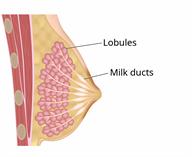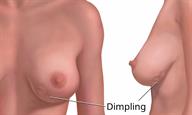Breast Cancer in Females: What to Know

Breast cancer is a malignant growth of tissue (tumor) in the breast. Unlike benign tumors, which aren't cancer, malignant tumors are cancer and can spread to other parts of the body.
The two most common types of breast cancer start in the milk ducts or in the lobules where milk is made in the breast. Breast cancer is one of the most common types of cancer in females.
What are the causes?
The exact cause of breast cancer is not known.
What increases the risk?
These factors may make you more likely to develop breast cancer:- Being 40 years old or older.
- Having a family history of breast cancer.
- Starting menopause after age 50.
- Starting your menstrual periods before age 12.
- Having never been pregnant or having your first child after age 30.
- Having never breastfed.
- A personal history of:
- Breast cancer.
- Dense breasts.
- Radiation exposure.
- Having the BRCA1 and BRCA2 genes.
- Having certain types of benign breast conditions.
- Exposure to the drug DES, which was given to pregnant people from the 1940s to the 1970s.
- Using birth control pills.
- Using hormone therapy after menopause.
- Drinking more than one alcoholic drink a day.
- Being very overweight (obese).
What are the signs or symptoms?
 Symptoms of breast cancer include:
Symptoms of breast cancer include:- A painless lump or thickening in your breast.
- Changes in the size or shape of your breast.
- Breast skin changes, such as puckering or dimpling that looks like an orange peel.
- Sores on the skin.
- Nipple abnormalities, such as scaling, crustiness, redness, or pulling in.
- Nipple discharge that is bloody or clear.
How is this diagnosed?
Breast cancer may be diagnosed by:- Taking your medical history and doing a physical exam. During the exam, your health care provider will feel the tissue around your breast and under your arms.
- Doing imaging tests, such as breast X-rays (mammogram), ultrasound, or MRI.
- Taking a sample of nipple discharge. The sample will be examined under a microscope.
- Taking a tissue sample from the breast. The sample will be examined to look for cancer cells.
- Having a biopsy of the lymph nodes near the affected breast. This is when a small piece of tissue is removed for testing.
Your cancer will be staged after diagnosis to determine the size, location, and if it has spread in your body. This will help your cancer care team decide on a treatment that will work best for you. You may need to have more tests to determine the stage of your cancer.
How is this treated?
Depending on the type and stage, breast cancer may be treated with one or more of these therapies:- Surgery. This may involve:
- Breast-conserving surgery which means that only the part of the breast containing the cancer is removed. Some normal tissue surrounding this area may also be removed.
- Surgery to remove the entire breast and nipple. Lymph nodes may also be removed.
- Radiation therapy. This uses high-energy rays to kill cancer cells.
- Chemotherapy, which is the use of medicines to kill cancer cells.
- Hormone therapy, which involves taking medicine to adjust the hormone levels in your body.
- You may take medicine to decrease your estrogen levels.
- This can help stop cancer cells from growing.
- Targeted therapy. These are medicines that are used to block the growth and spread of cancer cells. Targeted therapy may be used alone or in combination with chemotherapy.
- Immunotherapy, which is the use of medicines to boost the immune system to recognize and destroy cancer cells more effectively.
- A combination of surgery, radiation, chemotherapy, or hormone therapy may be needed to treat breast cancer.
Follow these instructions at home:
-
Take your medicines only as told.
- Eat a healthy diet. A healthy diet includes lots of fruits and vegetables, low-fat dairy products, lean meats, and fiber.
- Make sure half your plate is filled with fruits or vegetables.
- Choose high-fiber foods such as whole-grain breads and cereals.
-
Consider joining a support group. This may help you cope with the stress of having breast cancer.
- Talk to your health care team about exercise and physical activity. The right exercise program can:
- Help prevent or reduce symptoms such as fatigue or depression.
- Improve overall health and survival rates.
Where to find more information
-
American Cancer Society: https://www.cancer.org/cancer/breast-cancer.html
-
National Cancer Institute: https://www.cancer.gov/types/breast
Contact a health care provider if:
-
You have a sudden increase in pain.
-
You have any symptoms or changes that concern you.
-
You lose weight without trying.
-
You notice a new lump in either breast or under your arm.
-
You develop swelling in your arm or hand.
-
You have a fever.
-
You notice new tiredness or weakness.
Get help right away if:
-
You have chest pain.
-
You have trouble breathing.
-
Do not wait to see if the symptoms will go away.
-
Do not drive yourself to the hospital.
This information is not intended to replace advice given to you by your health care provider. Make sure you discuss any questions you have with your health care provider.

